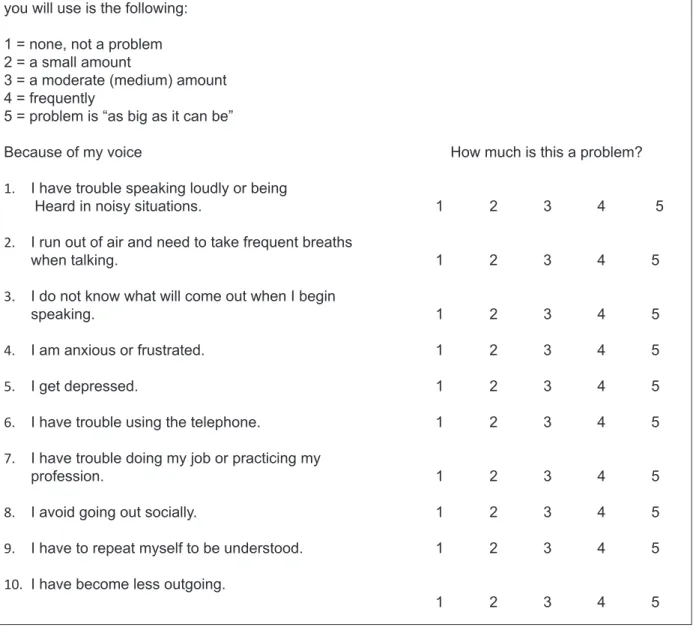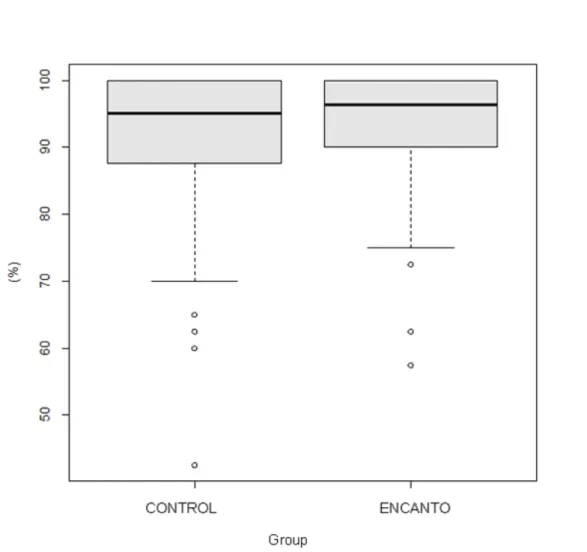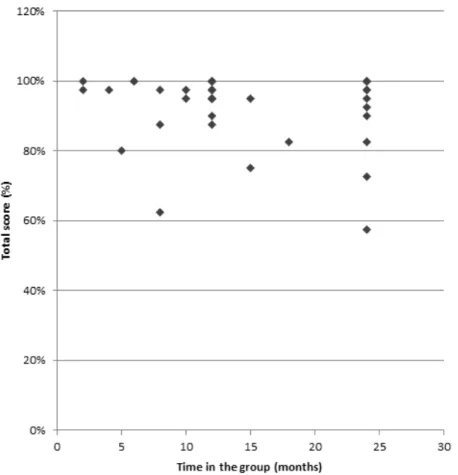INFLUENCE OF CHORAL SINGING ON
THE VOICE-RELATED QUALITY OF LIFE
OF PUBLIC HEALTH SERVICE USERS
Influência do canto coral na qualidade de vida em voz
dos usuários do serviço público de saúde
Bárbara Pereira Lopes Lobo (1), Adriana Maria de Lima e Souza Gomes (2),
Alessandra Mara Oliveira dos Santos (2), Matheus de Souza Klein (2),
Camila Lacerda Silveira Rocha (2), Juliane Ribeiro da Silva (2)
(1) Hospital Municipal Odilon Behrens (HOB), Belo Horizonte,
MG, Brasil.
(2) Prefeitura Municipal de Belo Horizonte, Belo Horizonte,
MG, Brasil.
to isolation, which, consequently, creates a decrease in their quality of life ². Therefore, it is believed that the prevention of vocal injuries and promoting voice quality corroborate the improvement of communi-cation and social relations, as it avoids isolation, as well as being economically viable to promoters since they require only basic healthcare technologies ³.
The beneits of an action with the goal of
promoting socialization and communication become
even more intensiied when it is established collec -tively. Currently, it is known that collective health
experiences allowed in group interventions, value
and legitimize knowledge, and make those involved feel participant and co-responsible for their own health, transcending the biomedical model of
INTRODUCTION
Voice is one of the most beautiful expressions
of humankind, as it doesn’t only facilitate commu-nication, but it is also able to convey the speaker’s feelings and personal characteristics such as age, gender, personality, as well as relate to the mental state of the individual ¹.
When this communication tool is compromised in some way, interaction between subjects can be
diicult and thus make them less sociable and prone ABSTRACT
Purpose: to investigate the voice-related quality of life of participating in a singing group promoted by public health system professionals. Methods: the study was conducted with 86 individuals of
both sexes, 46 made up the control group, and 40, the study group, whose members participated in
the singing group. Participants completed the questionnaire Voice-Related Quality of life (V-RQOL)
validated for Brazilian Portuguese. To ind the diference between the means of the groups, was used the nonparametric Mann-Whitney test, with signiicance <0.05. Results: the average age of the
groups were 60,82 for the control group, and 58,95 study group, with no statistical diference between
the groups. The total scores and related to each domain separately, were well similar between groups,
with no signiicant diference (p = 0.9295). Furthermore, it was found that the residence time in the
EnCanto group did not inluence the outcome scores. Conclusion: there was no signiicant diference between the scores of the groups, which may have been inluenced by the fact that both have presented scores within the normal range. Similarly, the scores were not diferentiated by time spent in the study group, which may be related to the antagonistic inluence caused by presbylarynx process, because
it is a predominantly elderly population. However, further studies are needed.
This is a cross sectional study.
All participants signed the TCLE (acronym in Portuguese for Informed Consent Form) and this study was approved by the Ethics Committee of Belo Horizonte’s Health Department under the advice number 328,911.
Eighty-six (86) individuals participated in the
study, SUS (acronym in Portuguese for Public Health System) users in the city of Belo Horizonte.
Among the participants, 40 belonged to the group
Encanto, which in this research is constituted as the study group, being mostly women (90%) and
the average age was 60.82 years (SD=7.46). The remaining 46 individuals composed the control
group, which was composed of health clinic users located in the same district frequented by those participating in the study group, with an average
age of 58.95 years (SD=13.92) and also composed,
predominantly by women (89.1%). It is important to point out that the groups were matched by gender,
age and socio-cultural context.
The study excluded individuals participating in
the group Encanto for less than one month and who did not belong to the coverage area of health clinics located in the Barreiro District in Belo Horizonte. Regarding the control group, the people who participated in some activity involving the practice
of singing were excluded, as well as those who
couldn’t be matched to the study group by gender,
age and socio-cultural context.
The analysis of the vocal impact on quality of life was assessed using the QVV (acronym in Portuguese for Voice-Related Quality of Life) questionnaire, validated in Brazilian Portuguese in 2009 9. This questionnaire aims to measure
the impact of vocal disorders in various aspects of life related to oral communication, comprising 10 items divided into two areas: socio-emotional and physical. This instrument follows a numerical scale of 1 to 5 and the scale values correspond to
the following situations: 1 = not a problem, 2 = it is a small problem, 3 = it is a moderate / medium problem, 4 = it is a big problem and 5 = it is a very big
problem (Figure 1). The analysis is performed from the score of each area as well as the total score, and as closer as the result is to 100, the better is the subject’s voice-related quality of life 9.
person 4.
As an example of a successful collective
intervention, a study described in the literature
investigated the efects of group vocal therapy of dysphonic teachers and found signiicant statistical
improvement in participants’ voice-related quality of life as well as an association of this positive outcome to the group treatment category 5.
However, one cannot deny how challenging it is keeping the participants of a group focused and committed to a common purpose, requiring that their coordinators use a few strategies that facilitate this process, among which one may include the use of musicality. Music has been used in health, not only as a promotional tool, but also for treatment of injuries and to emphasize the comfort of terminally ill patients, as it promotes well-being, autonomy
and expression of emotions 6. In addition, this
powerful art positively impacts the quality of life of
health services users and may even inluence blood
pressure control and chronic pain 7,8.
With the aforementioned focus, the group
Encanto was created in 2011, coordinated by speech therapists of NASF (acronym in Portuguese for
Support Center for Family Health) in the city of Belo Horizonte, which aims to promote communicative and interactive quality among participants, using music as the primary element of its operation. The group is divided into three subgroups that gather at
diferent locations in the Barreiro District, facilitating
user access and their participation. However, there are times when they all come together in one place to fraternize and conduct presentations of songs rehearsed during meetings.
Interventions such as this should be investigated
as for the beneits generated in the community
Name___________________________________________________ Date: __________
Age: ___________________________
We are trying to understand better how a voice problem can interfere with the daily life ac-tivities. We present a list of possible problems related to the voice. Please answer all the questions based on how your voice has been over the last two week. There are no right or wrong answers.
To complete the questionnaire, consider both how severe the problem is and how often it occurs, evaluating each item below according to the amount of problem that you have. The scale that you will use is the following:
1 = none, not a problem 2 = a small amount
3 = a moderate (medium) amount 4 = frequently
5 = problem is “as big as it can be”
Because of my voice How much is this a problem?
1. I have trouble speaking loudly or being
Heard in noisy situations. 1 2 3 4 5
2. I run out of air and need to take frequent breaths
when talking. 1 2 3 4 5
3. I do not know what will come out when I begin
speaking. 1 2 3 4 5
4. I am anxious or frustrated. 1 2 3 4 5
5. I get depressed. 1 2 3 4 5
6. I have trouble using the telephone. 1 2 3 4 5
7. I have trouble doing my job or practicing my
profession. 1 2 3 4 5
8. I avoid going out socially. 1 2 3 4 5
9. I have to repeat myself to be understood. 1 2 3 4 5
10. I have become less outgoing.
1 2 3 4 5
performed.
Both the total scores, as well as those related to each separate area proved very similar between groups (Table 1).
By analyzing the total scores of the groups with the nonparametric Mann-Whitney test, there was no
signiicant diference (p=0.9295); which can also be
displayed graphically (Figure 2).
Similarly, it was found that the length of stay in the group Encanto did not inluence the outcome of
scores (Figure 3).
program Excel 2007 and the nonparametric
Mann-Whitney test for independent samples, in
order to verify the signiicance level of p in relation to
the total score of the groups; considering signiicant
p values < 0.05.
RESULTS
Since the groups that make up this study were
matched by gender, age, and socio-cultural context,
Table 1 – Mean values of the scores by the groups.
Social-emotional domain Physical domain Total score
EnCanto 96% 90% 92%
Control 96% 88% 91%
life, may not have proved higher than the control group because both were already located within the normal range. In this case, participation in the group
Encanto would be important not to promote voice-related quality of life, but to prevent the emergence of vocal disorders that may, in the future, negatively impact such quality of life. This is in agreement with the literature, which features choral singing as a maintenance strategy of vocal health, and is also considered a prophylactic measure for voice aging
12.
In addition, one should take into consideration
that one of the criteria for control group exclusion
constituted in practicing some activity that involved
singing, since this practice requires diferent
breathing and phonation adjustments from those that occur in the spoken voice, being far more
complex and reined 13. So, disassociating these
subjects from a practice that involves a greater vocal demand, as in singing, can lead them to underes-timate their vocal symptoms not realizing them as negatively impacting the quality of life, thus bringing, their scores up.
This study also showed that the time spent
DISCUSSION
The lack of signiicant diference between the scores of the surveyed groups may make, at irst,
one think that the Encanto group, whose main objective is to promote communicative and inter-active quality among its participants, does not
positively inluence the voice-related quality of life
of its members. However, this result can lead us to
several relections that justiies it.
Firstly, considering that according to the protocol used, the higher the score, the better the voice-related quality of life of the subjects (Figure 1), it can be seen that the average shown by the two groups in this study (Table 1) is similar to the average voice-related quality of life of the Brazilian population, as
can be veriied in the literature, whose benchmark index for individuals without vocal complaints is 94.3% (SD=8.5) for the physical area, 98% (SD=6.5) for the socio-emotional area and 95.5% (SD=8.7) for
the total score 10. This result is also close to the one
presented by elderly choir members, whose average total score found in the literature was 96.7% 11.
Therefore, the results of the study group, in other
impact that activities promote for the quality of life
of the population, it is believed that diferent results
could have been seen with other protocols; since reports as reduction in the use of antidepressants, blood pressure control, increased energy, among others, are present in weekly meetings held by the group, but were not included in this study because they are not directly related to the voice. Thus arises the need for more comprehensive studies to verify
the beneits obtained by participating in the group.
CONCLUSION
The study showed no signiicant diference
between the scores of the participants of the group
Encanto and the control group regarding the
voice-related quality of life, which may have been inlu -enced by the fact that both groups have presented scores within the normal range.
Similarly, the scores were not diferentiated by
length of stay in the Encanto group, which may be
related to antagonistic inluence caused by presby
-larynx process.
However, many other beneits not covered by the protocol used in this study were veriied by the
participants in the Encanto group and it is important to perform further studies.
the one hand, there was an increase of knowledge and practice of proper vocal techniques for singing, favoring rising scores 14, on the other hand, laryngeal aging and appearance of presbyphonia cooperate to reduce the values, since the study group, as an average, is composed of elders.
Corroborating this inding, studies report that the longer the singer’s experience, lesser will be
his or her vocal disadvantage, since the necessary muscle adjustments at the beginning of his or her performance as a singer can lead to discomfort as
they are diferent from the customary ones used in
speech, and they are reduced over time. Thus, the shorter the period of singing voice development, greater will be the perceived vocal disadvantages
15,16. However, one should take into account that this
study includes mostly individuals over 45 years old, age after which begins the presbylarynx process,
which constitutes the aging of laryngeal structures, leading consequently to varying vocal impacts 17.
Therefore, the antagonistic action of the factors contribute to the scores remaining stable over participation time in the group Encanto.
And inally, it should be considered that the instrument used (QVV) may have been insuicient
to verify the actual impact that participation in the group Encanto generates for the quality of life of its
members, since the protocol is restricted exclusively
to the vocal aspects. Also considering that currently
RESUMO
Objetivo: investigar a qualidade de vida relacionada à voz de participantes de um grupo de canto
promovido por proissionais do sistema público de saúde. Métodos: o estudo foi realizado com 86
indivíduos de ambos os sexos, dos quais 46 compunham o grupo controle e 40, o grupo em estudo,
cujos usuários participavam do grupo de canto. Os participantes preencheram o questionário de
Qualidade de Vida em Voz validado para o português brasileiro. Para veriicar a diferença entre as médias dos grupos foi utilizado o teste não paramétrico de Mann-Whitney, com signiicância < 0,05.
Resultado: as médias de idade dos grupos foram 58,95 anos para o grupo controle e 60,82 anos
para o grupo estudo, não havendo diferença estatística entre as médias. Tanto os escores totais,
quanto os relacionados a cada domínio separadamente, se mostraram bem semelhantes entre os
grupos, não tendo sido encontrada diferença signiicante (p=0,9295). Além disso, foi veriicado que o
tempo de permanência no grupo EnCanto não inluenciou no resultado dos escores. Conclusão: não
houve diferença signiicante entre os escores dos grupos, o que pode ter sido inluenciado pelo fato
de ambos já apresentarem escores dentro da normalidade. Semelhantemente, os escores não foram diferenciados pelo tempo de permanência no grupo EnCanto, podendo estar relacionado à inluência
antagônica causada pelo processo de presbilaringe, por se tratar de uma população predominante -mente idosa. Entretanto, são necessários novos estudos.
9. Gasparini G, Behlau M. Quality of Life: validation of the Brasilian version of the Voice-Related Quality Of Life (V-RQOL) measure. J. Voice. 2009;23(1):76-81. 10. Dassie-Leite AP, Lacerda Filho L, Weber J, Baldissarelli B, Delazeri S. Protocolos de
autoavaliação vocal: relação com aspectos sociodemográicos em indivíduos sem queixas de
voz. XX Congresso Brasileiro de Fonoaudiologia.
31/10 a 03/11/2012 Brasília – GO, Sâo Paulo, 2012. 11. Penteado RZ, Penteado LAPB. Percepção da voz e saúde vocal em idosos coralistas. .Rev
CEFAC [periódico na internet]; 2010 [acesso em:
04/03/2015]. 12(2): [10p]. Disponível em: http:// www.scielo.br/pdf/rcefac/v12n2/191-08.pdf
12. Meirelles RC, Bak R, Cruz FC. Presbifonia. Rev HUPE- UERJ. 2012;11(3):77-82.
13. Behlau M. Voz: o livro do especialista. Volume 2. Rio de Janeiro. Revinter, 2005.
14. Coelho ACC, Daroz IF, Silvério KCA,
Brasolotto AG. Coralistas amadores: auto-imagem,
diiculdades e sintomas na voz cantada. Rev CEFAC. 2013;15(2):436-43.
15. Paoliello K, Oliveira G, Behlau M. Desvantagem vocal no canto mapeado por diferentes protocolos de
autoavaliação. CoDAS [periódico na internet]; 2013
[acesso em: 04/03/2015]. 25(5): [5p]. Disponível em: http://www.scielo.br/pdf/codas/v25n5/pt_2317-1782-codas-25-05-00463.pdf
16. Madazio G, Leão S, Behalu M. The phonatory deviation diagram: a novel objective measurement of vocal function. Folia Phoniatr Logop. 2011;63(6):305-11.
17. Behlau M. Voz: o livro do especialista. Volume 1. Rio de Janeiro. Revinter, 2001.
REFERENCES
1. Pinheiro MG, Cunha MC. Voz e psiquismo: diálogos entre fonoaudiologia e psicanálise. Dist
Comun. 2004;16(1):83-91.
2. Spina AL, Maunsell R, Sandalo K, Gusmão R,
Crespo A. Correlação da Qualidade de Vida e voz com atividade proissional. Braz J Otorhinolaryngol.
2009;75(2):275-9.
3. Ferri SMN, Pereira MJB, Mishima SM, Caccia-Bava MCG, Almeida MCP. Soft technologies as generating satisfaction users of a family
health unit. Interface – Comunic. Saúde Educ.
2007;11(23):515-29.
4. Favoreto CAO, Cabral CC. Narratives on the health-disease process: experiences in health education operational groups. Interface – Comunic. Saúde Educ. 2009;13(28):7-18.
5. Law T, Lee KY, Ho FN, Vlantis AC, van Hasselt AC,
Tong MC. The efectiveness of group voice therapy:
a group climate perspective. J. Voice, [periódico
na internet]; March 2012 [acesso em: 04/03/2015]. 26(2): [8p]. Disponível em: http://www.sciencedirect. com/science/article/pii/S0892199710002274.
6. Bergold LB, Alvim NAT. Visita musical como uma
tecnologia leve de cuidado. Texto Contexto Enfer. 2009;18(3):532-41.
7. Zanini CRO, Jardim PCBV, Salgado CM, Nunes MC, Urzêda FL, Carvalho MVC et al. O efeito da musicoterapia na Qualidade de Vida e na pressão arterial do paciente hipertenso. Arq Bras Cardiologia.
2009;93(5):534-40.
8. Leão ER, Silva MJP. Música e dor crônica
musculoesquelética: o potencial evocativo de imagens mentais. Rev Latino-am. Enfermagem.
2004;12(2):235-41.
Received on: February 19, 2014
Accepted on: June 16, 2015
Mailing address:
Bárbara Pereira Lopes Lobo,
Av. Paranaguá, 379, apto 404, bloco 1,
Vila Paranaguá
São Paulo – SP – Brasil


